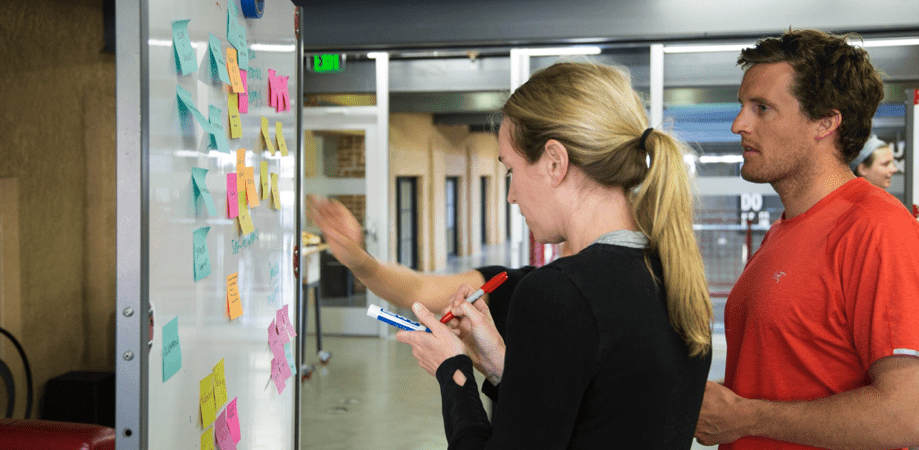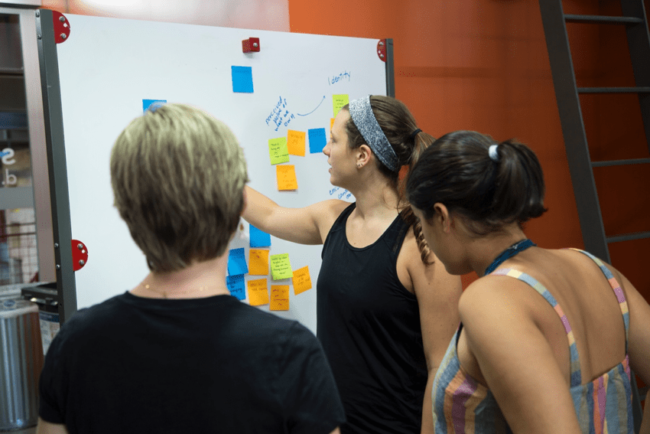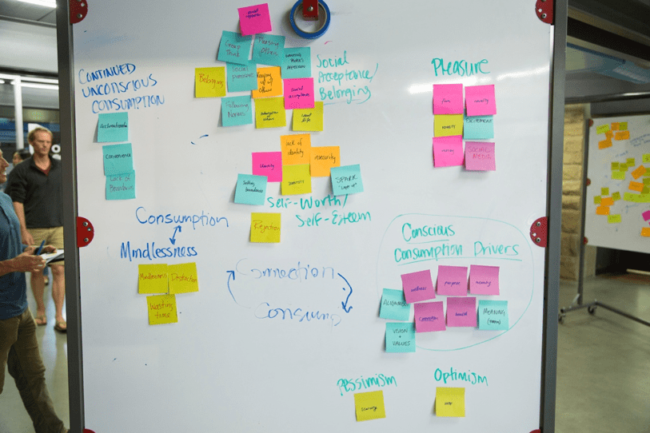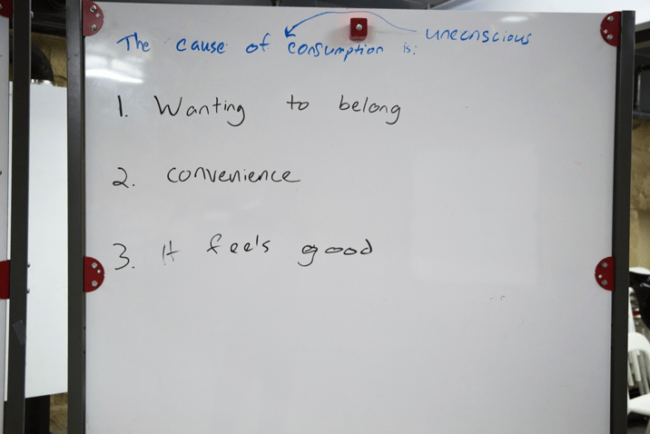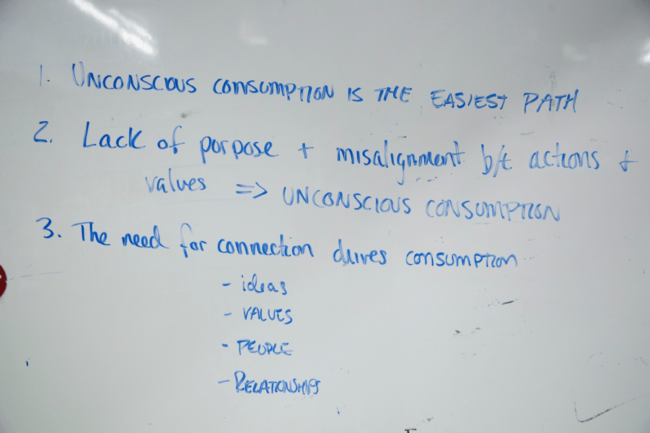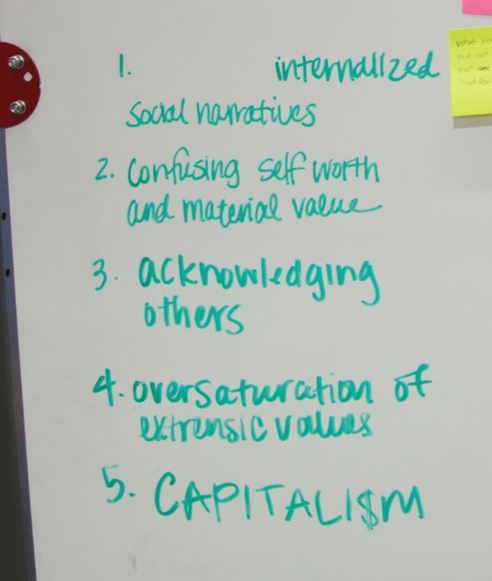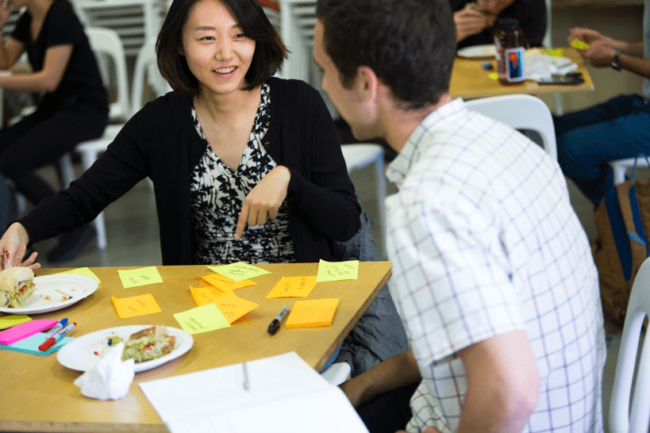What are the drivers of unconscious consumption?
On May 14th, an interdisciplinary group of fifteen Stanford undergraduate and graduate students came together at the Stanford Design School to explore consumption in America. American culture in many ways revolves around consumption. While we have known for decades that our consumption often detracts from the well-being of others, we are quickly finding that often our consumption actually detracts from our own well-being. But breaking out of this cycle of inefficient and unhealthy consumption can be difficult when we are not mindful or conscious of our purchasing patterns and the powers that influence those patterns.
The Empowering Conscious Consumption working group represents a broad spectrum of students from the field of psychology, to documentary film, to environmental engineering. This group will participate in a series of workshops over the next six months to explore unconscious consumption and develop strategies to influence the main drivers of consumption. The workshop hosted on May 14th was the first in the series and focused on mapping the underlying drivers of consumption and developing a series of problem statements that capture the primary drivers of consumption.
This working group takes a very different approach from the normal academic round-table discussion of an issue, which generally assesses from a 30,000-foot view. Our goal in this first workshop was to create an environment of belonging, a community of people passionate about exploring the causes of consumption, and a space in which people were willing to be vulnerable and explore this challenge in their own lives. In my experience at Stanford, academics often discuss the issue, but they make it impersonal, they don’t look inwards and explore how the issue manifests itself in their own personal life.
To kick off the workshop we did a series of design thinking ice breakers to foster human connection and create a safe physical and psychological space. Once this space was established, we ran a series of activities to begin to brainstorm the drivers of unconscious consumption and captured those thoughts on sticky notes.
As a group, we then watched an interview in which a British woman discussed her challenge with overshopping controlling her life. We asked the students to write down the specific reasons that they were hearing as to why she overshopped; reasons ranged from her identity tied to her clothing, to wanting to be socially accepted.
The real brainstorming energy began to flow when each student started sharing stories and experiences in their personal life in which they observed unconscious and/or unhealthy consumption or when they experienced it themselves. I was inspired by how quickly the barriers dissolved and the awkwardness dissipated between students who had never before met. The curiosity, passion and energy began to flow. For about 45 minutes, each group was lively and listening and present for each other. They were engaged and animated in a manner that I rarely see in an academic setting.
With tables full of sticky notes, each group then began grouping the sticky notes in thematic areas on a white board and naming these thematic areas. Again, I was pleasantly surprised by how quickly these groups honed in on the main drivers that I have been exploring for the last six months in my work.
The main thematic areas groups highlighted that drivers of consumption include self-worth, pleasure, belonging and social acceptance, identity, marketing, capitalism, our surroundings and social norms.
Once each group had finished mapping the drivers, they spent 15 minutes defining 3-5 problem statements for the phrase, “The cause of unconscious consumption is…”.
The environmental movement has long focused on using extrinsic tools, the carrot and the stick, to influence human consumption behavior. While these approaches such as taxes, regulations and incentives are incredibly valuable efforts, there is another space that is largely overlooked. The student-developed problem statements indicate that we may want to devote more resources to understanding and influencing the psycho-emotional drivers of consumption. We would be wise to spend more time listening to the individual instead of grouping people into tribes and writing them all off as one type of person or another.
In the following workshops, we will take one of these thematic problem areas per workshop and brainstorm how we can begin to influence it. Given the problem statements that were developed in the first workshop, I have a feeling we will spend much less time talking about technology and policy and much more time talking about psychology, sociology and the human experience.
My main take-away from this whole experience? To really dig into an issue and understand it, we have to make it personal. We must inspire people to reflect on their own lives and create a source of empathy between themselves and the people most affected. We have the opportunity to create spaces of belonging and community, where people are comfortable being vulnerable and can create deep and meaningful connections. The academic world shouldn’t solely be about knowledge creation. We are humans too, and we need belonging.
According to a 2015 study, only 50% of Stanford students reported Diener Flourishing Scale scores indicating positive mental health. Worse, 7% of students reported suicidal ideation, that’s over 1,000 students. We should be designing academic workshops, programs and activities that are spaces that connect, spaces that push back against the ego-centric, competitive, individualism that is a primary cause of loneliness, toxic to mental and emotional health.
And maybe this is all connected; the space of belonging we created in the workshop could be vital to reducing consumption writ large. Maybe if we want to solve unconscious consumption, we should work on making sure that people are experiencing deep and meaningful connections in the workplace and in their everyday lives – soul food. I hypothesize that if we focus on community, if we focus on belonging, maybe we won’t need to consume as many material goods to fill those holes in our hearts.
Special thanks to the Stanford Vice Provost for Graduate Education Student Projects for Intellectual Community Enhancement program for providing the funding for this working group and the Stanford d.School for providing the studio space to realize the event. Additional thanks to Nico Sandi for providing the images used in this article.
The MAHB Blog is a venture of the Millennium Alliance for Humanity and the Biosphere. Questions should be directed to joan@mahbonline.org
MAHB Blog: https://mahb.stanford.edu/blog/empowering-conscious-consumption
The views and opinions expressed through the MAHB Website are those of the contributing authors and do not necessarily reflect an official position of the MAHB. The MAHB aims to share a range of perspectives and welcomes the discussions that they prompt.
